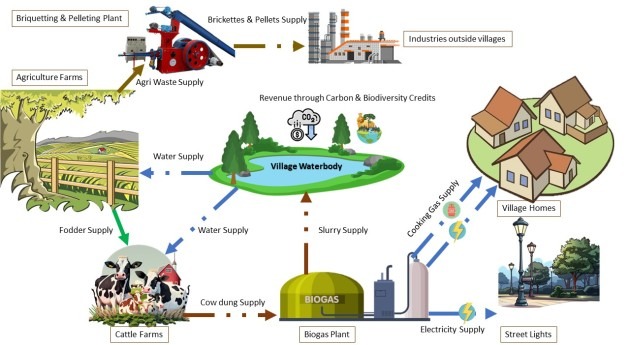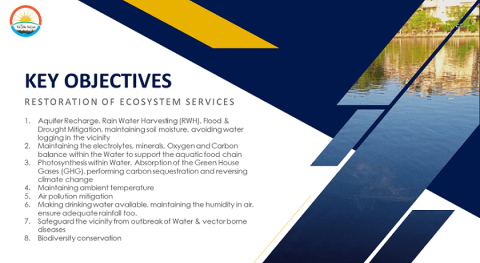Background
India has always been a village-based economy, not because of the sheer size of the country and the huge number of villages, but because of the ancient research in sociology and the sustainable economy design built by the ancient Indians based on the Vaidic wisdom. Even since the human settlements came into existence due to the invention of discovery of agriculture, the hunter gatherer human beings started settling in clusters which was the earliest form of villages. Eventually, the civilizations grew and the states were built, kings stayed in the administrative headquarters with their chieftains with all the amenities and the marketplaces, which gave birth to the concept of cities.
From ancient times till date, the number of villages across the globe has always been higher than the cities. Therefore, the most sustainable design that Bharat had all through the ages was that the “villages were the producers and cities were the market places”. All innovations, inventions and production happened in the villages and they were in turn brought to the cities to sell. But this design changed with the invasions of Bharat and the growth of Western influence on the Indian economy. Eventually, we were made to believe that all inventions happen in the west and are then brought to the country and the trend continued post 1947 as well. That’s why Mr. Swaminathan and Dr. Kurien were sent to the west to bring in the fundamental changes in the way we farm (agriculture & dairy sector), to bring in Green and White revolutions in the country. Now the production was shifted to urban and the rural became the consumer, i.e., fertilizers, insecticides, pesticides, weedicides, fungicides, hormones and antibiotics etc. or for that matter the mechanized agriculture tools like tractors or harvesters or threshers or ploughers or bailers – all were made in factories and sold in the villages.
Rural innovations were termed as “jugaad”, traditional medicines were terms as “neem-hakeem khatra-e-jaan”, traditional practices were reframed as “desi”, all in pursuit to dissuade people from believing in them, and increased their dependence upon buying factory-made produces. Eventually, the village farmer didn’t even understand, when they stopped living for their own sustainability and started living to keep the factories running. They are the only beings who buy everything they need from the retail market at the retail prices, while they sell everything, they produce in the wholesale market at the wholesale prices. That’s why we see so much hue and cry about the MSP (Minimum Support Price).
Just imagine this ironic situation, all factories and the manufacturing industries across the globe put ten raw materials or components to produce one finished product and sell it at MRP (Maximum Retail Price) and make profits, while in farming one seed produces thousands of seeds to be sold at the MSP (Minimum Support Price) and incur losses to the extent that the farmer eventually takes drastic actions like committing suicide.
This made the rural economy, the backbone of Bharat derail in order to impact the whole country. Therefore, the government’s focus shifted towards the restoration of the rural economy and supporting the villages with developmental packages like MSP for the crops, farm subsidies, fertilizer subsidies, agricultural loans, kisan credit cards, MNREGA kind of schemes to ensure employability, road constructions, NABARD, Cooperative schemes, rural housing projects, water supply irrigation projects and so on. But in spite of running these projects for decades, no substantial impact was observed.
The Sumit Bose Committee Report 2017
This called for detailed research to understand the rural dynamics to analyze the success and failures of policies and to single out the fundamental mistake of what was going wrong with the schemes – was it the plan itself the supply chain the implementation or the government machinery itself or was it the beneficiaries themselves exploiting the core philosophy of the programs? This led to the formation of a committee of experts to carry out the research work in the year 2016, which is known as the Sumit Bose Committee (after the committee chair).
The committee identified that the villages are very different from all other higher formats of governance in the country. Education levels are low, emotions are high (in fact the governing reasons behind decision making), technical manpower is missing, people from the villages are happy to move to cities, but reverse migration seldom happens.
And the kind of jobs/responsibilities being showered upon the villages/gram panchayats for the rural development are highly skilled and technical. From PM awas yojna (grameen), to constructing toilets under swachh barat mission (grameen) to PM Gram Sadak Yojna to Drone Didi etc. execution of all these projects would need engineers, accountants, managers and supervisors, who earn hefty salaries in cities. Why would they migrate to villages without their bare minimum salaries?
So, if they are given even ₹ 50K salaries per month, and we have three such people in a village (an engineer, an accountant, and a manager / supervisor / CEO), each village’s monthly salary disbursement itself would cost ₹ 150K per month. Just multiply it with the number of villages, the figure will go astronomical, because we have 6.80 Lakh villages. It will amount to ₹ 102 Lakh Crores per month, only for salaries. Which is neither economically viable, nor even practical.
So, what the way out?
This can only be made possible, when we return to the original native Indian design of creating self-sufficient, revenue generating, producer villages, which are profitable and capable of running their own development models as well as sustainable robust dependable economy.
Understanding the Right Approach
We’ve already witness numerous examples of importing a successful model from outside and implementing it without redesigning it for Indian needs, as per the cultural ethos, sentiments and challenges. So not repeating the same mistakes committed in the history, we need to do a SWOT analysis of our situation and then design a strategy which is for the villages, by the villages and of the villages.
We need to find out answers to some basic questions –
1- What is there in the Indian villages in abundance?
2- What abundance is not utilized or commercialized at all? Or if there’s any attempt done for utilization in past, what was the cause of its failure?
3- What could be possible ways of commercializing it?
4- If commercialized, is there a need in the market? Can the produce be consumed of internal usage or for revenue generation?
5- Can the exercise make the villages self-reliant? Or can it generate revenue too?
The Village SWOT
In the quest for making the village SWOT, we need to understand the commonalities amongst all these 6,80,000 villages in Bharat. Occupation of the people, their day-to-day routine, their livelihood, their problems, their assets and liabilities irrespective of the regional biases or the social structure or the geographical boundaries.
We find that all the villages have certain traits in common, which become their points of strength –
1- Essentially the rural communities are into farming, aquaculture, horticulture, apiculture or animal husbandry.
2- Fundamentally they have common issues – electricity, water supply (drinking & irrigation), sanitation (animal waste), fuel (for cooking) etc.
3- Generally, all villages have huge clusters of cultivable land and a substantial cattle population.
4- Mostly, the Waterbodies are contaminated with wasteWater, run off from agriculture land mixed with pesticides and fertilizers.
5- Largely, the community living is not there which was the norm earlier, e.g., community ownership of a common grazing ground for the cattle or any other community ownership like a panchayat bhawan / village mandi etc.
So, if we categorize the SWOT, it’ll be something like this –
A- Strength – Farm land, Cattle population, Waterbodies
B- Weakness – Animal waste, Agriculture waste and waste Water
C- Opportunity – transforming liabilities to assets
D- Threat – organizing the community to work together in spite of their differences
The Remedial Design for Reinstation of the Rural Economy
We can sum up to three key liabilities – the agricultural waste, the animal waste and the wasteWater. All of them are found in abundance in the villages, cause sanitation problems, result in spreading of diseases and haven’t been addressed till date.
If we could plan to generate revenue out of these, or make any functional usage for the rural consumption itself, solving any of their problem – it could lead some steps toward a sustainable, self-sufficient village.
We know that there were attempts of promoting biogas plants (popularly known as gobar gas plants) in mid 80s, but none of them had been successful for the sheer design, because of the waste slurry generated out of the plants had no sustainable disposal plan / consumption.
We also know that some of the agriwaste is used as fodder, but not everything can be utilized there as
All wasteWater and Biogas Slurry to come in to the village Waterbodies, wherein it would be treated with Cownomics® Technology, to be transformed in to neuro-immuno booster for plants, bords and animals.
· Water for Irrigation, Animal Husbandry & Aquaculture, making the farms go disease, pests and weather resilient, reducing input cost and multiplying the yield. In turn, maximizing the farmer’s profitability.
· Restoration of natural resources (the Soil, Water and Air quality), ensuring healthier plants, animals and birds (native biodiversity)
· Better Water table, aquifer correction & recharge
· Overall better public health index (saving on the medical expenses)
· Reduced ambient temperature of the village (saving on the electricity usage)
· Flood, drought & Waterlogging mitigation
· Better WASH infrastructure







